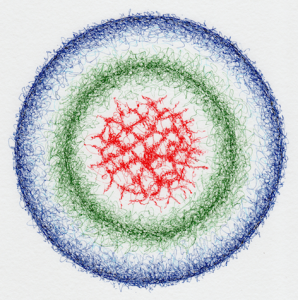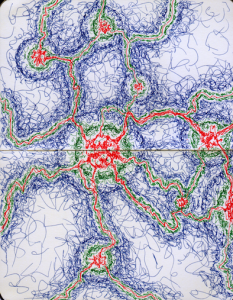In my last post, Integral intelligence for the city – part 1, I outlined two maps that help us see cities as whole, integrated systems: the nested holarchy of city systems and Spiral Dynamics integral. The two remaining maps complete the collection of maps presented by Marilyn Hamilton in Integral City (click here for the book and here for the website).
The two maps I present today are the integral map and the scalar, fractal relationship map.
1. The integral map
The basics of this intelligence have been applied in the Nest City blog in my post entitled City – a dance of voice and values. The map here is very simple: four quadrants that help us notice within our selves and any scale of human system the individual and collective, and the internal and external.
As a map, it helps us track this territoity. It isn’t the territory itself, but a frame for us to explore the territory we are experiencing, or not. Marilyn Hamilton applies this lens expressly to the city:
- Upper Left (individual, internal, subjective, intangible) – appreciates the beauty of life and the city, particularly in living systems. This is the psychological well-being of the city.
- Upper Right (individual, external, objective, tangible) – appreciates the truth of life: the actions that support our material survival in the city. From this perspective we determine the energy flow in the city for life: water, food, waste, shelter, clothing. Our attention here gives us a quality built environment. This is the biological well-being of the city.
- Lower Right (collective, external, interobjective, tangible) – appreciates the the truth that emerges from the material systems generated by the Upper Right. From here the artifact of the city emerges for us to live in collectively – our combined habitat. This is the social well-being of the city.
- Lower Left (collective, internal, intersubjective, intengible)- appreciates the Goodness in life. From this perspective we see the moral qualities of our collective choices. We weave this voice into the stories of everyday life. We see this view in our formal laws. This is the cultural-well-being of the city.
2. The scalar, fractal relationships of human systems
I have not written about this map in an explicit fashion so far, but the spirit of this map is within Next City. Two images I have shared here are fractal: our work and habitat, and the city dynamic.

(For further description of work and habitat, visit this post: The development of cities is a survival skill. For further description of the city dynamic, visit this post: Dynamically steering cities to the future.
By fractal, I mean that regardless of the scale, the pattern is the same. The image and concept of our work evolving in response to our habitat, social and physical, is one that holds for individuals, families, neighbourhoods, cities and so on. We don’t come up with new ways of doing things but for in response to some kind of challenge that we face. This pattern is in place regardless of scale of human system.
The other important consideration when using this map, is that each individual whole that makes up a larger system (think nested holarchy of city systems in my last post) is each in response to her/his/its own set of life conditions, making a soup of values and responses to changing conditions. Understanding these dynamics are critical to understand as we upgrade our work to ensure cities are habitats for citizens to thrive.
The pattern
We build habitats for ourselves at many scales. We build habitats for self, for family, for our neighbourhood, our organizations, our whole cities, regions, nations, continents and even our planet. We have even begun building habitats for ourselves when we spend time in outer space. The scale at which we do this work is expanding, yet it is only as good as the health of the wholes that make up the whole. The well-being of selves, families, neighbourhoods, organizations, cities, etc., determine the well-being of the larger wholes. Our work, as people keen on creating cities that serve citizens, is always at many scales, and in many directions (think quadrants) at once.
Marilyn Hamilton – An Integral City “is dynamic, adaptive, and responsive to its internal and external life conditions. An Integral City acts much like a complex adaptive human system that concentrates habitat for humans like a beehive does for bees or an anthill does for ants.”[1]
My next post will explore ecosphere intelligence – our ability to locate cities in appropriate locations.
